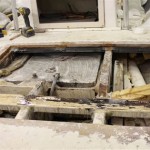How To Install Laminate Wood Flooring On Stairs And Landing
Installing laminate wood flooring on stairs and landing areas can significantly enhance a home's aesthetic appeal and increase its value. While it can be a challenging project, particularly for novice DIYers, careful planning, precise execution, and the right tools can yield professional-looking results. This article provides a comprehensive guide on how to successfully install laminate flooring on stairs and landings.
Before initiating the installation process, a thorough assessment of the existing staircase and landing is crucial. This involves identifying any structural irregularities, assessing the condition of the subfloor, and determining the appropriate type and quantity of laminate flooring required. Proper preparation is key to ensuring a stable and visually appealing finished product.
Preparing the Subfloor and Gathering Materials
The subfloor, which is the surface onto which the laminate flooring will be installed, must be clean, level, and structurally sound. Any imperfections, such as protruding nails, screws, or uneven surfaces, need to be addressed before proceeding. If the existing subfloor is made of wood, ensure that it is free from rot, mold, or significant damage. For concrete subfloors, verify that they are properly cured and free from excessive moisture.
To prepare a wooden subfloor, thoroughly inspect it for any loose boards or squeaks. Secure any loose boards with screws and fill any gaps or cracks with wood filler. Sand down any uneven areas to create a smooth and level surface. If the existing subfloor is severely damaged, consider replacing it entirely with a new layer of plywood or oriented strand board (OSB).
Concrete subfloors require a different approach. Clean the surface thoroughly to remove any dirt, dust, or debris. Use a concrete grinder or self-leveling compound to address any uneven areas or imperfections. It is essential to test the moisture level of the concrete before installing laminate flooring, as excessive moisture can lead to warping or buckling of the laminate. Use a moisture meter to determine the moisture content and apply a moisture barrier if necessary.
Once the subfloor is properly prepared, gather all the necessary materials and tools. This includes the laminate flooring itself, stair nosing (also known as stair treads or bullnoses), construction adhesive, shims, measuring tape, a circular saw or miter saw, a jigsaw, a tapping block, a hammer, a level, a square, safety glasses, and a dust mask. Ensure that you have an adequate supply of each item to avoid interruptions during the installation process.
Selecting the right type of laminate flooring is also important. Consider factors such as the thickness of the laminate, its durability rating (AC rating), and its resistance to moisture. For stairs and landings, choose a laminate flooring that is specifically designed for high-traffic areas and that has a non-slip surface to prevent accidents.
Stair nosing is a crucial component of the installation, as it provides a finished edge for the laminate flooring on the stairs and enhances safety by providing a visual cue for the edge of each step. Choose stair nosing that matches the color and style of the laminate flooring for a seamless and professional-looking result. Stair nosing is usually installed using construction adhesive and screws.
Cutting and Installing Laminate Planks on the Landing
Begin by measuring the landing area to determine the number of laminate planks needed. Account for any irregularities in the shape of the landing and plan the layout accordingly. It is often beneficial to start by laying out the planks without adhesive to get a visual representation of the final result and to make any necessary adjustments.
Using a circular saw or miter saw, cut the laminate planks to the appropriate size. Be precise in your measurements and cuts to ensure a tight and uniform fit. Remember to leave a small expansion gap (typically ¼ inch) around the perimeter of the landing to allow for natural expansion and contraction of the laminate due to changes in temperature and humidity. This gap can be concealed later with baseboards or quarter-round molding.
Apply construction adhesive to the back of each laminate plank and carefully position it on the subfloor. Use a tapping block and hammer to gently tap the planks into place, ensuring that they are tightly connected. Work in small sections, applying adhesive and installing planks as you go. Use shims to maintain the expansion gap around the perimeter of the landing.
If the landing has any corners or irregular shapes, use a jigsaw to cut the laminate planks to the appropriate shape. Take accurate measurements and use a template if necessary to ensure a precise fit. When installing laminate flooring around obstacles such as pipes or doorways, use a hole saw or jigsaw to create the necessary openings.
After all the laminate planks have been installed on the landing, allow the adhesive to dry completely according to the manufacturer's instructions. This typically takes 24-48 hours. Once the adhesive is dry, remove the shims and install baseboards or quarter-round molding to conceal the expansion gap and provide a finished look.
Installing Laminate Planks and Stair Nosing on the Stairs
Installing laminate flooring on stairs requires more precision and attention to detail than installing it on a flat surface. Start by measuring each stair tread and riser to determine the size of the laminate planks and stair nosing needed. It is important to note that each stair may have slightly different dimensions, so measure each one individually.
Cut the laminate planks and stair nosing to the appropriate size using a circular saw or miter saw. Ensure that the cuts are precise and clean to create a professional-looking finish. It is often helpful to create a template for each stair to ensure that the laminate planks and stair nosing fit properly.
Begin by installing the stair nosing on the top of each stair tread. Apply construction adhesive to the back of the stair nosing and carefully position it on the tread, ensuring that it is flush with the edge of the stair. Use screws to secure the stair nosing in place, drilling pilot holes first to prevent splitting the wood. The screws should be countersunk so that they are flush with the surface of the stair nosing.
Next, install the laminate planks on the stair tread. Apply construction adhesive to the back of each plank and carefully position it on the tread, ensuring that it is tightly connected to the stair nosing. Use a tapping block and hammer to gently tap the planks into place. Leave a small expansion gap between the laminate planks and the wall or stringer.
Finally, install the laminate planks on the stair riser. Apply construction adhesive to the back of each plank and carefully position it on the riser, ensuring that it is flush with the tread above. Use a tapping block and hammer to gently tap the planks into place. If necessary, use shims to support the laminate planks while the adhesive dries.
Repeat this process for each stair, ensuring that each stair is properly measured, cut, and installed. Pay close attention to detail and make any necessary adjustments to ensure a consistent and professional-looking finish. Once all the laminate planks and stair nosing have been installed, allow the adhesive to dry completely according to the manufacturer's instructions.
After the adhesive is dry, inspect the stairs carefully for any imperfections or gaps. Use wood filler to fill any small gaps or cracks and touch up any areas that need attention. Install quarter-round molding along the base of the stairs to conceal the expansion gap and provide a finished look.
Proper installation of laminate flooring on stairs and landings requires patience, precision, and attention to detail. By following these steps carefully and using the right tools and materials, it is possible to achieve professional-looking results and enhance the beauty and value of your home. Remember to always prioritize safety and wear appropriate protective gear when working with power tools and adhesives.

How To Install Laminate Flooring On Staircase Step By Guide

How To Install Laminate Flooring On Stairs Direct Wood

Installing Laminate Flooring On Stairs Diy

How To Install Laminate Flooring On Stairs Direct Wood

How To Install Vinyl Plank Flooring On Stairs In 6 Steps

How To Install Laminate Flooring On Stairs 13 Steps

Installing Laminate Flooring On Stairs Diy

How To Install Laminate Flooring On Stairs Direct Wood

Transition Between Laminate Floor To Stairs Installation Of Stair Nose

Laminate Flooring Stair Installation A Step By Guide
Related Posts








